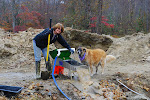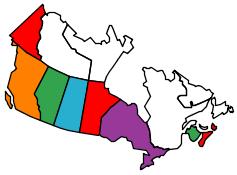We’ve been in the desert before. But it never ceases to amaze us how each and every desert can be so different. Before getting to the Mojave, though, we had to leave the greater LA area and head through the freshly snow capped Cajon Pass.

The drive north through the pass and on “The 395” (Californians like to give all their roads the “title” THE; i.e. The 5, The 15, The 40, The 395) was proof that the storm was not yet over. In fact we had to pull off several times to clear snow and ice buildup on the monster windshield of the coach. It just plain wasn’t made to blast through snow, freezing rain and the like. The cross wind at the increasing altitudes didn’t help much either. We had an ongoing discussion about turning around and going back to wait it out, but there were no guarantees that would work much better so we kept a slow and steady pace toward Johannesburg. Johannesburg? No. We’re not in South Africa, we’re in Southern California. But wait. Our destination is Duisenburg. Duisenburg? Now you’re going to Germany? Nope. That’s Southern Cal too, on the western part of the Mojave Desert. With all this lousy (by our standards) weather, it surely didn’t feel like we were headed for another dry desert experience. But as we passed Johannesburg and headed down into the big valley ahead (not too far from Death Valley), the weather went from rotten to rosy and a vista of clear skies and bright sunshine stretched out ahead.
We pulled into the LDMA Prospecting Camp at Duisenburg later in the day than we had intended, but after a day of tough driving conditions, it sure felt like a welcome port in the storm.

The end of this day brought another beautiful desert sunset and we built ourselves a camp fire and sat outside in the admittedly colder than we like it temperatures. It was too nice not to….

There is no potable water in this camp. So job one the next morning was to head into town to fill the collapsible 5 gallon jugs we carry for such occasions. We found the Water District up atop the hill. Self service. Fill your containers from a garden hose and drop your payment in a slot in the door. The water rate was 1.8 cents per gallon. We got 20 gallons and Marilyn put 2 quarters through the door. “That’s too much.” “No, that’s with the tip for having water ready to go.” Whatever!

Back at camp we headed over to the mining shack to meet the caretakers and get the lay of the land. The old barrel wood stove was cranking out some much appreciated heat and the fresh coffee pot was ready to tap into. Mmmmmmmm. Like the vast majority of the LDMA caretakers, these folks were friendly and happy and as helpful as could be. We got some tips for what to look for and where to look for it. That’s all the head start we could ever ask for. That’s why they call it prospecting, yes?

Here’s my “sign of the times” for Duisenburg, seen on the porch of the LDMA camp: "The Taliban Special.” If you are not in the habit of enlarging the photos to look for detail, you might just want to do it on this one. The image and the text are both worthwhile examinations!

Well, despite the fact that it’s been fairly wet in the Mojave this season we did manage to find some dry dirt to work. Dirt must be quite dry to use a dry washer gold recovery system effectively. It’s about the only game in town without water for high banking or sluicing or dredging. Since it was pretty cold, even the well for “working water” was shut down for fear of freeze. I should mention that they offered to get us whatever water we might need for panning, but that wasn’t the mission on this stop. The dry washing process places dry as possible dirt on a sluice through which air is then pumped from underneath, forcing air up through the dirt and vibrating the sluice simultaneously. The combo process further dries the dirt, and makes the “heavies” like black sand and gold fall to the bottom of the rips where they are trapped and remain until clean up. Watching the process you would swear it cannot work. However, you would have “sworn” for nothing as it does work fairly well, especially if the material is run through the process several times- which we always do. And so it was that on our first day’s attempt to locate and claim gold from the Mojave Desert and the great state of California - we done good!

This photo of working the claim may give you some idea of the size and scope of the work at hand. You can, and we do, move a lot of dirt and some very big rocks all for the express purpose of finding a little, tiny (miniscule, sometimes) piece of gold. But as I’ve said before. It’s not about the gold! Well, maybe a little bit about the gold. But mostly, it’s about the process. The whole process. Travel to the spot. Learn about the place and the geography and the history of the place. Learn how to look for the gold as you might expect to find it in this location. It’s different at every venue. Find a place to dig or prospect. Dig for the gold. Get tired for the gold. Find the right process to get the gold from the concentrates. Then sit back at the end of the day, head cleared of pretty much everything else, and appreciate the effort and the reward, which to us seems to be great - even when it is small.

Of course, just as there are still very real Pirates in the Caribbean (and also Somalia), there may still be a claims jumper or two out here in the gold fields. So Abby, The Trusty Wonder Dog goes along out to the job site and chews on a bone in the shade of our 4X4 “donkey” named Quigley and protects us from anyone who would try to “jump” our claim. Then again, they better not try to take that bone away!

Alas, after two good days of dry washing, the next winter weather system moved in and we were pretty much stuck in camp. Literally. Mud. Or ice. Or snow. Or fog. Just bad. Now we start listening closely to the weather band emergency broadcasts. This is not the best time for California to have its worst storm of the year. Not when our next move will carry us over the mountains again to Las Vegas. Right now there are high winds and deep snow advisories and projected road and pass closings. We sit waiting for a break in the weather. Oh, and did I mention the “dead zone?” We have a very good cell tower signal here in camp. Hard to believe but true. Very good computer card signal as well. But they don’t work. Neither one of them. And no one knows why- but they are willing to bet you a pocket full of gold that they won’t! The “dead zone” that Verizon always advertises they don’t have???????? I know where it is, is; I know where it issssss….































